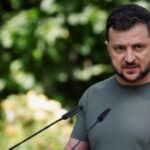
Negotiators from Iran, the United States and the European Union prepared Thursday to resume monthslong, indirect talks over Tehran’s tattered nuclear deal, even as international inspectors acknowledged the Islamic Republic began a new expansion of its uranium enrichment.
The resumption of the Vienna talks, suddenly called Wednesday, appears not to include high-level representation from all the countries part of Iran’s 2015 deal with word powers. That comes as Western officials express growing skepticism over a deal to restore the accord and the EU’s top diplomat has warned “the space for additional significant compromises has been exhausted.”
Iran’s top negotiator, Ali Bagheri Kani, had arrived in Vienna for the talks, Iranian state media reported. U.S. Special Representative for Iran Rob Malley also was on hand, tweeting Wednesday that “our expectations are in check.”
As in other talks, the U.S. won’t directly negotiate with Iran, instead speaking through EU diplomat Enrique Mora. The U.S. hasn’t had direct talks with Iran since then-President Donald Trump unilaterally withdrew America from the accord in 2018. Mora also met Thursday with Russian Ambassador Mikhail Ulyanov, who has represented Moscow’s interests in the talks.
But going into the negotiations, Iran laid out a maximalist stance. Through its state-run IRNA news agency, Tehran denied that it had abandoned its effort to get America to delist its paramilitary Revolutionary Guard as a terrorist organization as a precondition to the talks. Meanwhile, IRNA also quoted its civilian nuclear chief as saying turned-off surveillance cameras of the International Atomic Energy Agency only would be switched back on once the West abandons an effort to investigate manmade traces of uranium found at previously undisclosed sites at the country.
Those positions could doom the talks. Iranian officials had been trying to offer optimistic assessments of the negotiations while alternating blaming the U.S. for the deadlock, likely worried a collapse of the talks could see its rial currency plunge to new historic lows.
Iran struck the nuclear deal in 2015 with the United States, France, Germany, the United Kingdom, Russia and China. The deal, formally known as the Joint Comprehensive Plan of Action, saw Iran agree to limit its enrichment of uranium under the watch of U.N. inspectors in exchange for the lifting of economic sanctions.
As of the last public IAEA count, Iran has a stockpile of some 3,800 kilograms (8,370 pounds) of enriched uranium. More worrying for nonprofileration experts, Iran now enriches uranium up to 60% purity — a level it never reached before that is a short, technical step away from weapons-grade levels of 90%.
Those experts warn Iran has enough 60%-enriched uranium to reprocess into fuel for at least one nuclear bomb. However, Iran still would need to design a bomb and a delivery system for it, likely a monthslong project. Iran maintains its program is for peaceful purposes, though its officials increasingly are discussing the country’s ability to build a nuclear bomb if it chose — previously a taboo topic there.
Meanwhile Thursday, those U.N. inspectors at the IAEA said that they had verified Iran had begun feeding uranium gas into two IR-1 cascades previously unused at its underground Natanz facility. Those cascades will enrich uranium up to 5%.
The IAEA inspectors also verified that Iran had completed installation of three advanced IR-6 cascades at the plant, each comprised of up to 176 centrifuges. The IAEA said those cascades had yet to be fed uranium. Iran also told the IAEA it planned to installed another six IR-2M cascades in a new operating unit at Natanz as well, inspectors said.
___
Follow Jon Gambrell on Twitter at www.twitter.com/jongambrellAP.




